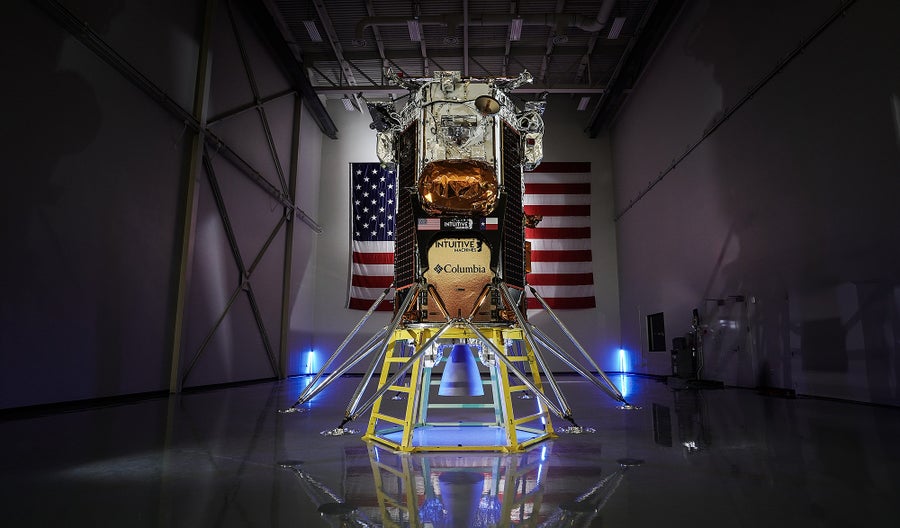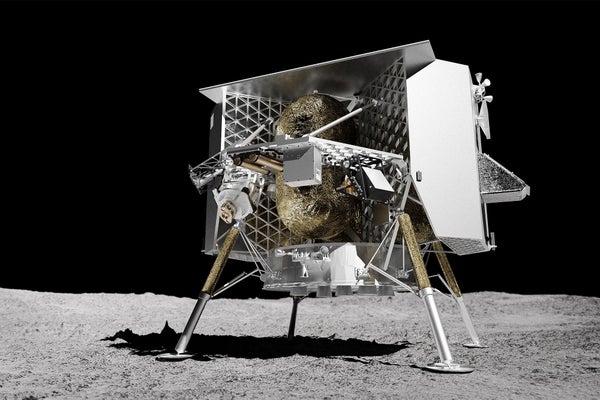For the first time since 1972’s Apollo 17 mission, the U.S. is about to launch spacecraft that will attempt soft landings on the moon’s surface. But in a twist, these two uncrewed missions aren’t operated by NASA. Instead they’re run by private companies.
As soon as January 8, the Pittsburgh-based company Astrobotic will be on its way to the moon with a boxy lander called Peregrine. And on January 12 the Houston-based company Intuitive Machines will follow suit with its lander, called Nova-C. Combined, the missions will be flying about a dozen payloads on behalf of NASA, as well as other objects that include a physical Bitcoin and miniature sculptures by artist Jeff Koons.
The spacecraft are flying under the banner of NASA’s Commercial Lunar Payload Services (CLPS) initiative, which is encouraging private industry to take over the routine delivery of scientific instruments to the moon. Under CLPS (pronounced “clips”), companies own and operate lunar landers, and NASA pays a fixed price for the firms to ship the agency’s hardware. In 2019 NASA paid Astrobotic $79.5 million and Intuitive Machines $77 million for the companies’ imminent missions—a fraction of what it has spent on robotic landers in the past.
On supporting science journalism
If you're enjoying this article, consider supporting our award-winning journalism by subscribing. By purchasing a subscription you are helping to ensure the future of impactful stories about the discoveries and ideas shaping our world today.
“It can be hard for people to either understand or remember that NASA is purchasing a delivery service with CLPS; these are not NASA missions,” says Ryan Watkins, a program scientist in NASA’s Exploration Science Strategy and Integration Office, which supports CLPS. “It’s just a way that we are flying our instruments to the moon.”
While this approach is new for moon missions, NASA has used versions of it before in low-Earth orbit. Since 2008 the agency has been contracting with private companies to send cargo to the International Space Station, and it has more recently done so to send crews to the ISS as well. But CLPS comes with plenty of risk. Historically, only about five out of every nine attempted moon missions have succeeded, and neither Astrobotic nor Intuitive Machines has ever flown before, much less touched down on the moon. No commercial spacecraft has safely landed on another celestial body yet.
“It is a high-risk, high-reward operation,” Watkins says.
Peregrine Takes Flight
One of the first companies to take on this risk is Astrobotic, a firm that was founded in 2007 and began as a competitor for the now-defunct Google Lunar XPRIZE. Sixteen long years later, the company’s Peregrine Mission 1 is weeks away from journeying to the moon. “This is the big day, the big moment,” says Astrobotic CEO John Thornton. “We’re thrilled that we were honored with the opportunity to do it—and now it’s put up or shut up, right?”
Assuming it launches on January 8, Peregrine Mission 1 could attempt a lunar landing as early as February 23, Astrobotic official say. Its destination is Sinus Viscositatis (“Bay of Stickiness”), an ancient lava flow that sits next to the Gruithuisen Domes, two hardened mounds of silica-rich lava in the moon’s northern midlatitudes. A future CLPS mission, slated for 2026, will target the geologically enigmatic domes directly. Peregrine’s job is to do initial reconnaissance of the neighborhood.
The lander will be carrying six payloads on NASA’s behalf. One of them, a device called PITMS (Peregrine Ion-Trap Mass Spectrometer), will measure how water molecules move around the lunar surface as sunlight heats it up. Meanwhile a NASA neutron spectrometer will look for hydrogen-bearing minerals in the regolith near Peregrine, a proxy for water content.
In addition, Peregrine bears 15 payloads for other public and private clients. Among them is the Mexican Space Agency’s COLMENA, the country’s first moon-bound scientific instrument. Once activated, the device will fling out five circular wheeled robots, each not much bigger than a frozen waffle, that will then assemble into a bigger solar panel. Other payloads onboard serve less scientific, more symbolic purposes. One, an archival disk provided by the U.S.’s Arch Mission Foundation, includes 60 million pages worth of material, including a copy of Wikipedia. Two others, supplied by the U.S. firms Celestis and Elysium Space, contain ashes of people who wished to have portions of their remains sent to the moon.
Astrobotic’s most visible risk on the way to the moon may well be its trip to space. The lander will be hitching a ride on the first-ever flight of Vulcan Centaur, the newest heavy-lift rocket from the aerospace firm United Launch Alliance (ULA). While ULA has a 100 percent mission success rate across more than 155 previous missions, the maiden voyage of any new rocket inevitably comes with nerves.
“Does it add to the excitement, the challenge, the risk and certainly the butterflies? Yes,” Thornton says. “But at the same time, we feel confident.”
Nova-C Goes Down Under
Like Astrobotic, Intuitive Machines—founded in 2013—cut its teeth as a competitor for the Google Lunar XPRIZE and then pivoted into commercial deliveries. Present plans call for Intuitive Machines’ Nova-C lander to launch atop a SpaceX Falcon 9 from Cape Canaveral, Fla in mid-February, although an associated date for the subsequent lunar landing attempt remains undisclosed. “It is behaving beautifully, and we’re really excited and on target,” says Steve Altemus, CEO of Intuitive Machines.

The Intuitive Machines lander Nova-C, a hexagonal cylinder standing four meters tall and about 1.6 meters wide, will launch with a fully fueled mass of 1,908 kilograms. The version of the lander used for the company’s IM-1 mission can carry about 130 kg of payload to the lunar surface. Credit: Intuitive Machines/Flickr (CC BY-NC-ND 2.0)
Unlike Astrobotic, Intuitive Machines is traveling to the moon’s southernmost latitudes. At NASA’s request, the mission—known as IM-1—is targeting a landing site at Malapert A, a crater nestled in the lunar equivalent of the Antarctic interior. If successful, IM-1 will be just the second soft landing in the moon’s south polar region, following India’s Chandrayaan-3 mission.
IM-1 will be flying 11 payloads in all, five for NASA and six for other clients. One of the non-NASA payloads plays a key structural role. The sportswear company Columbia supplied some of the lander’s insulation: a metallic film developed for some of the firm’s jackets. Another payload is aiming for a spacecraft first: EagleCam, built by Embry-Riddle Aeronautical University, will eject a small camera from Nova-C when the lander is 30 meters from the lunar surface during its final descent. This camera will then free fall and hit the lunar surface in time to document Nova-C’s landing attempt. If successful, EagleCam will capture the first third-person images ever taken of a spacecraft landing on another celestial body.
As EagleCam looks at Nova-C from afar, one of the onboard NASA payloads will be looking down. This system, called SCALPSS (Stereo Cameras for Lunar Plume-Surface Studies), consists of four cameras that ring the bottom of Nova-C. SCALPSS will take videos and three-dimensional images of the spacecraft’s exhaust plume during landing to see how it interacts with the lunar surface. The data should help inform simulations of scaled-up moon landings, such as those planned for NASA’s Artemis program.
Wishing for Success, Ready to Face Failure
Since winning their NASA awards in 2019, Astrobotic and Intuitive Machines have faced challenge after challenge to get to the launchpad. Just as the two companies were ramping up work, the COVID pandemic threw the global supply chain into a tailspin, slowing down the firms’ and their suppliers’ ability to get even minor parts such as springs.
Both programs also did everything they could to learn from the four lunar landers that have crashed since 2019: Russia’s Luna 25, the Vikram lander on India’s Chandrayaan-2 mission, the Japanese company ispace’s Hakuto-R and the Israeli nonprofit SpaceIL’s Beresheet. “We’ve looked at those exact scenarios for our own program, and we’re fairly confident that if we did have an anomaly that it won’t be because of those issues,” Thornton says.
The companies say that they are prepared to weather harder-than-expected landings, with their next missions already booked with NASA. As soon as next year Intuitive Machines’ second flight will ferry a NASA-built drill to the lunar south pole region. Astrobotic, in turn, will be delivering a water-hunting NASA rover called VIPER.
As devastating as losing these first missions would be, the companies add that they are ready to stay the course in hopes of building a working lunar economy. “We are steely-eyed rocket scientists,” Altemus says. “We dust ourselves off, we maybe have a pity party for a day, and then we go figure out how we’re going to do it the next time and make it right.”
